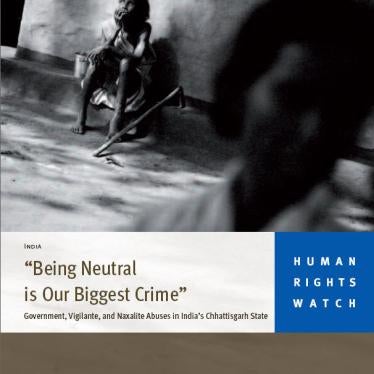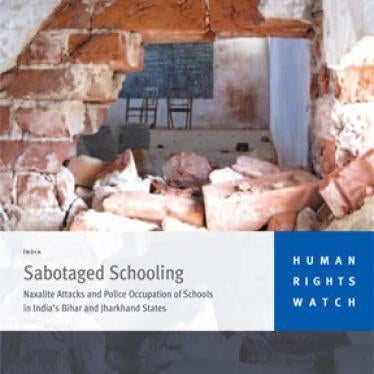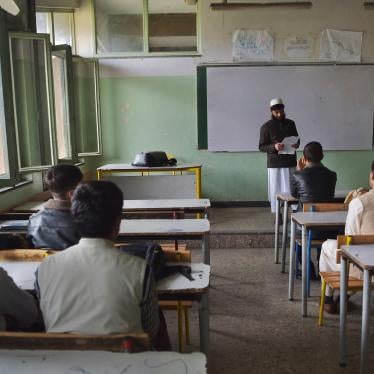(New York) - India should take immediate steps to protect children caught up in its conflict with Maoist rebels, in light of a report today by United Nations Secretary-General Ban Ki-moon, Human Rights Watch said. This is the first time that the long-running Maoist conflict in India has appeared in the secretary-general's report to the UN Security Council about the use of children in armed conflict around the world.
India should immediately review state government policies of occupying and using school buildings as part of operations against Maoist armed groups, known as Naxalites, and give schools better protection from Maoist attacks, Human Rights Watch said. Human Rights Watch also called upon the Maoists to immediately cease their recruitment and use of children, and stop attacking schools.
"Both the security forces and the Maoists in India are exploiting and harming children, destroying their chances at an education and causing damage that will affect their entire lives," said Bede Sheppard, Asia researcher on children's rights at Human Rights Watch. "The new UN report will focus international attention on this tragic situation."
The UN Security Council has stated repeatedly that it will consider targeted sanctions, including arms embargoes, against parties to armed conflict that do not end their use of child soldiers.
The secretary-general's report describes how the Maoists, particularly in Chhattisgarh state, are recruiting and using boys and girls in their ranks, and that they have carried out systematic attacks on schools to damage and destroy government structures and to instill fear among local residents.
The report also noted that government security forces have been occupying school buildings in the states of Chhattisgarh and Jharkhand. In 2009, security forces similarly occupied school buildings in Bihar and West Bengal states.
"Having security forces occupy school grounds puts children and their education at unnecessary risk," Sheppard said. "Now this practice is putting India's reputation on the world stage at risk."
In a 2009 report, "Sabotaged Schooling," Human Rights Watch documented how government security forces - both police and paramilitary police - occupy school buildings as bases for anti-Maoist operations, sometimes only for a few days, but often for periods lasting several months and even years. Sometimes the security forces take over entire buildings, while in other places they occupy parts of school buildings, with students trying to carry on their studies in the remaining space, often under distracting and even frightening circumstances.
Human Rights Watch has also documented that at least 34 schools in Jharkhand and 16 schools in Bihar were attacked by the Maoists during 2009. These do not include schools that were occupied by security forces at the time of attack. Most of the attacks occurred at night when students and teachers were not there.
Maoist attacks and school occupations by security forces unnecessarily place students at risk of harm, and lead many to drop out or to interrupt their studies. Girls are especially likely to drop out following a partial occupation of a school because of harassment, or perceived harassment, by the security forces. Often, schools are closed altogether and students may not be able to attend at all or are forced to move into inferior sites, to study outdoors, or, for those able to reach them, to travel to schools farther away. Students also reported to Human Rights Watch that it was traumatic to witness security forces beating suspects on school grounds.
In a 2008 report, "‘Being Neutral is Our Biggest Crime,'" Human Rights Watch also documented the use of children in the conflict in Chhattisgarh state. The Maoists deploy children to gather intelligence, for sentry duty, to make and plant landmines and bombs, and to engage in hostilities against government forces. They organize children ages 6 to 12 into children's associations (bal sangams), indoctrinating, training, and using them as informers. Typically, children over the age of 12 are recruited into other Maoist ranks and trained in the use of rifles, landmines, and improvised explosive devices. Children in Maoist armed guerrilla squads (dalams) are involved in fighting with government security forces.
The secretary-general's report, which covers all of 2009, was submitted in response to Security Council Resolution 1882 of August 4, 2009, in which the council requested a briefing on the issue of children and armed conflict around the world. India was one of 22 countries highlighted in the report, which will be debated by the Security Council in June.
"Secretary-General Ban has brought international attention to the mistreatment of children in India's Maoist conflict," Sheppard said. "The Security Council should be prepared to take action if the Indian government and the Maoists do not act to better protect children."







